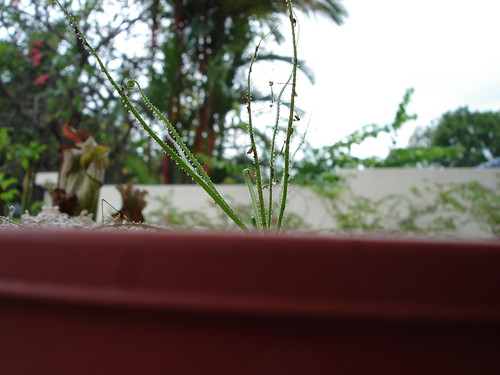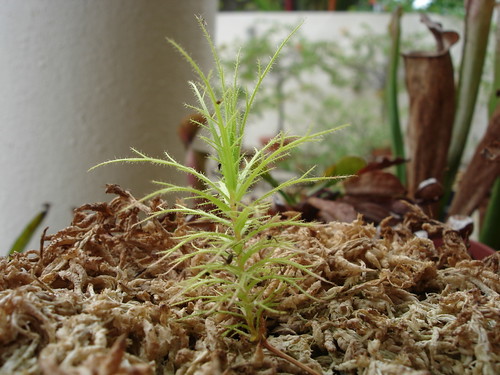|
|
Post by ifurita on Dec 23, 2007 23:43:13 GMT 8
After a long time of waiting, I finally got germination for these two! They don't seem too popular with most CP growers, especially in our region, so just thought I'd give them a little time in the spotlight, haha. Drosophyllum lusitanicum:  Here's the best I can do to show the dew...  And Roridula dentata:  |
|
|
|
Post by ameliepoulain on Dec 24, 2007 0:48:05 GMT 8
ifurita, the Drosophyllum lusitanicum looks so much like d. filiformis, what's the difference ? While the Roridula dentata is just like a tiny Xmas tree! Wouldn't it be fun to decorate it, the dew (does it dew?) would be sparkling like tiny blinking light. ;D Hehehhe... sorry, too many Xmas trees around,so I keep seeingone in everything!  I notice that the spag. moss in the R. dentata pot looks kinda dry, is it supposed to be like that? |
|
|
|
Post by David on Dec 24, 2007 13:22:37 GMT 8
Can you tell us alittle more about your Roridula dentata? Thanks
|
|
|
|
Post by ifurita on Dec 25, 2007 0:42:52 GMT 8
Athene, I think the main differences between Drosophyllum lusitanicum and all the Drosera are something to do with the dew and maybe the flowers, I agree that they look quite similar. In the wild, this plant grows in very cold and dry areas. Its growing requirements are totally different from D. filiformis though. This plant HATES water and has a tendency to rot if it gets too much, especially in the media. The sphag moss in the pot of Roridula is there mainly to prevent the media from churning up when watered, so I don't actually go out of my way to wet it when watering, heh. The Roridula does have extremely tiny drops of dew, I guess it'll be more obvious when the plant gets larger. I agree too, it looks a bit like an xmas tree! Yay, joy for the season!  David, what would you like to know about the Roridula dentata? Growing conditions, about the plant, or...? Its not a particularly popular CP with local growers it seems... |
|
|
|
Post by piscesilim on Dec 27, 2007 19:50:38 GMT 8
Cool! I am still waiting mine to be germinated.
One of the different between Drosophyllum lusitanicum and Drosera filiformis is the direction of the curved leaves tip.
But Ifurita. Did you give fertilizer to your Roridula? And how long you have keep it?
|
|
|
|
Post by David on Dec 27, 2007 22:31:02 GMT 8
Hi ifurita,
Was wondering how you manage to germinate your Roridula dentata if you grew it from seeds. They are known to be difficult to germinate. Also what fertilisers do you use if you use any since I do not see any assasin bugs on your plants. How long have you grown this "pet' of yours?
Is it true that the dews on it's leaves are very sticky as compared to sundews?
|
|
|
|
Post by ifurita on Dec 27, 2007 22:46:40 GMT 8
Hi Lim and David, I don't fertilize my Roridula at all. Its also not very old, 2-3 months at most since germination so far I think. Oh, yup, you're right David, Roridula is difficult to germinate. I didn't do anything special to mine, just sowed the seeds in the media. It took about a year before there was germination. The plant you see is still more or less a seedling, so there isn't that much dew yet, but its supposed to be true that the dew is more sticky...well, we'll know for sure in a few months time when the plant grows up  |
|
|
|
Post by David on Dec 28, 2007 8:30:51 GMT 8
My goodness! You waited one year for the germination. This plant must be a priceless treasure for you.
I wonder if we could rear assasin bugs with the plant. Wonder if the insects would continue to stay on the plant. Would be cool to see how the symbiosis between the plant and the insect happens.
|
|
|
|
Post by ifurita on Dec 28, 2007 11:21:18 GMT 8
Considering the difficulty in obtaining seed in the first place...yup, its priceless alright! I hope I can keep it alive...
Yeah...I want the bugs for the plant too. However, I think it has to be the correct species. The question is, where can these bugs be obtained?
|
|
|
|
Post by David on Dec 28, 2007 14:36:18 GMT 8
My guess we can only find these bugs in South Africa where the plants come from.
Found this info on Wikipedia. Interesting...
Pameridea roridulae lives in a symbiotic relationship with the carnivorous plant Roridula. There are two Roridula species: Roridula gorgonias and Roridula dentata. Pameridea marlothii only occurs on R. dentata, while P. roridulae exists on both.
Pameridea roridulae can only live on the plant Roridula feeding on insects that the plant captures with its mucilage-tipped trichomes. After devouring the captured arthropods, it then proceeds to excrete waste, which the plant absorbs using glands. It is therefore a symbiotic insect because of this. It mates, too, while on the plant, and hatchlings continue to live on the Roridula plant.
Since it is symbiotic with the Roridula plant, its status depends on the status of the plant. The Roridula plant is scarce in the wild, due to collecting, pollution, and habitat destruction, although it is secure in cultivation from avid carnivorous plant enthusiasts.
Pameridea roridulae and P. marlothii both have wings; however they are not very good fliers. They are small bugs, usually not reaching more than a few millimetres in size.
The relationship with Roridula consists primarily of the fact that Roridula produces resin that cannot digest the bugs like other carnivorous plants such as Dionaea muscipula, or Drosera, Pinguicula, Nepenthes and other carnivorous plants have. Thus, P. roridulae and P. marlothii devour the trapped insects on the Roridula and then excrete waste which is consumeable by the plant to supplement its carnivory since it grows in nutrient poor soil. Without the Roridula the Pameridea cannot find a food source; and ultimately die. They breed and live on the plant. Because P. roridulae and P. marlothii eat and digest the food for the plant, some carnivorous plant enthusiasts consider Roridula only sub-carnivorous; however it is only a matter of style. Even though S. purpurea uses a variety of worm to digest captured arthropods for them, and the same is for Darlingtonia californica, Roridula is related in these ways. Pameridea have special feet with hairs on them that allow them to run through the plants' resin without being caught themselves.
From ICPS FAQ...
Complicating things even more, there is a species of specialist spider (Synaema marlothi) that also lives on Roridula and preys upon captured insects as well as upon Pameridea. Its poop may very well end up being absorbed by Roridula too!
It was discovered in 2007 that Pameridea do not only eat bugs---they are generalist feeders that suck the juices of Roridula if food is not present. This helps sustain the Pameridea if captured food becomes rare. But this is also a factor in an interesting balance that apparently exists regarding the populations of Pameridea on Roridula plants. If the populations of Pameridea are very low, the plant suffers because it is not getting the nitrogen it needs. But if the populations of Pameridea become too large, the Pameridea begin to feed upon the saps of the Roridula, thereby damaging it. Perhaps the Synaema marlothi spiders help keep the Pameridea populations in check?
|
|
|
|
Post by strath76 on Jan 20, 2008 8:37:31 GMT 8
Athene, The Drosophyllum's trapping method is explained well in Barry Rices book 'Growing Carnivorous Plants'. He explains that the dropletts on the leaves do not actually 'glue' the prey to the leaves but that the droplet is transfered to the prey and it eventually drowns before being consumed. I suggest you track this book down as it has very good information on a variety of carnivorous plants.
Drosophyllum was originally classified as a Drosera but further studies revealed that it was sufficiently different to warrant it's own classification.
|
|
|
|
Post by ameliepoulain on Jan 20, 2008 8:50:53 GMT 8
thanks strath76 for the heads up. will try to look for it.
|
|